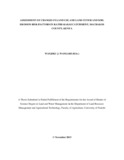| dc.description.abstract | Soil erosion is still one of the most important land problem and most pronounced form of soil degradation in Kenya. Assessment of existing soil conservation measures and soil erosion rates, which would assist in the development of appropriate soil and water conservation measures, is of essence to channel available resources in erosion risk areas. Semi structured questionnaires were administrated to a randomly selected farmers in Kathe-kakai catchment to identify existing soil conservation measures and factors that affect their adoption. An assessment of soil erosion using a modified revised universal soil loss equation (RUSLE) was used to estimate soil erosion rates and in Kathe-kakai catchment in Machakos County. Analyzes on landuse and land cover changes using Landsat images for years 1988, 2002 and 2014 were also carried out. Supervised classification and change detection were done using ENVI 4.7 Software. Soil analyses were carried out to determine whether landuse changes have affected soil properties and if these changes may cause an increase in soil erosion. The R factor (rainfall erosivity) was determined by interpolation of rainfall data from 8 stations in Machakos County. The K factor (soil erodibility) was estimated using a locally derived multiple regression equation. The LS factor (slope length and steepness) was calculated from digital elevation model. The C factor (Land cover factor) was determined using Landsat imagery for the area, P factor (conservation practices) was estimated from commonly used soil conservation measures. The R factor was estimated to be between 562 and 747 MJ mm/ha/yr while soil erodibility factor K was between 0.17 and 0.3. LS factor ranged from 0 to 413. A raster based geographic information system (GIS) was used to calculate soil loss and map hot spot areas. Estimates show erosion rates to be between 0 to 60 tons/ha/year, the highest amount recorded in areas with steep slopes and bare surfaces Approximately 54% of the area under study was within the tolerable soil erosion rate, which is taken to be 10 tons/ha/yr. Landuse and management systems were major factors associated with erosion. Results showed that 64% farmers have adopted at least one of SWC measures with 35% not adopting any at all. Terracing (21%), mixed cropping (34%), use of grasses (16%), cutoff drains (16%) were the major measures used by farmers due to their effectiveness in controlling soil erosion. Both membership in farmers group (p<0.01) and Education and training on SWC (p<0.05) had a positive correlation with adoption of SWC measures. Farmers identified poverty, ignorance and lack of technical advice as the major constrains to taping the full potential of soil and water conservation in the area.
During 1988 and 2014 there was an increase in barelands (14.9%), cultivated lands (68%), and decreased in shrub lands (-15%), forests (-64%), and water bodies (-55%). Changes in forests and cultivated lands were significant at (p<0.001) over the years. Laboratory tests showed that soil properties were indeed affected by landuse. Barelands and shrub lands were characterized by high bulk density of 1.6 to 1.8 g/cm2 and low hydraulic conductivity (0.4 – 1 cm/hr). Forests had moderate hydraulic conductivity 4cm/hr and a bulk density 1.3 g/cm2 .These results highlight the need for proper soil and water conservation measures especially in those areas mapped as erosion hot spots. Key words: Adoption, Soil and Water Conservation, Landuse planning, Community awareness, Change detection. | en_US |

